Chenyang Ge
A Lightweight Model for Perceptual Image Compression via Implicit Priors
Feb 19, 2025Abstract:Perceptual image compression has shown strong potential for producing visually appealing results at low bitrates, surpassing classical standards and pixel-wise distortion-oriented neural methods. However, existing methods typically improve compression performance by incorporating explicit semantic priors, such as segmentation maps and textual features, into the encoder or decoder, which increases model complexity by adding parameters and floating-point operations. This limits the model's practicality, as image compression often occurs on resource-limited mobile devices. To alleviate this problem, we propose a lightweight perceptual Image Compression method using Implicit Semantic Priors (ICISP). We first develop an enhanced visual state space block that exploits local and global spatial dependencies to reduce redundancy. Since different frequency information contributes unequally to compression, we develop a frequency decomposition modulation block to adaptively preserve or reduce the low-frequency and high-frequency information. We establish the above blocks as the main modules of the encoder-decoder, and to further improve the perceptual quality of the reconstructed images, we develop a semantic-informed discriminator that uses implicit semantic priors from a pretrained DINOv2 encoder. Experiments on popular benchmarks show that our method achieves competitive compression performance and has significantly fewer network parameters and floating point operations than the existing state-of-the-art.
Diffusion-based Extreme Image Compression with Compressed Feature Initialization
Oct 03, 2024Abstract:Diffusion-based extreme image compression methods have achieved impressive performance at extremely low bitrates. However, constrained by the iterative denoising process that starts from pure noise, these methods are limited in both fidelity and efficiency. To address these two issues, we present Relay Residual Diffusion Extreme Image Compression (RDEIC), which leverages compressed feature initialization and residual diffusion. Specifically, we first use the compressed latent features of the image with added noise, instead of pure noise, as the starting point to eliminate the unnecessary initial stages of the denoising process. Second, we design a novel relay residual diffusion that reconstructs the raw image by iteratively removing the added noise and the residual between the compressed and target latent features. Notably, our relay residual diffusion network seamlessly integrates pre-trained stable diffusion to leverage its robust generative capability for high-quality reconstruction. Third, we propose a fixed-step fine-tuning strategy to eliminate the discrepancy between the training and inference phases, further improving the reconstruction quality. Extensive experiments demonstrate that the proposed RDEIC achieves state-of-the-art visual quality and outperforms existing diffusion-based extreme image compression methods in both fidelity and efficiency. The source code will be provided in https://github.com/huai-chang/RDEIC.
RGB Guided ToF Imaging System: A Survey of Deep Learning-based Methods
May 16, 2024Abstract:Integrating an RGB camera into a ToF imaging system has become a significant technique for perceiving the real world. The RGB guided ToF imaging system is crucial to several applications, including face anti-spoofing, saliency detection, and trajectory prediction. Depending on the distance of the working range, the implementation schemes of the RGB guided ToF imaging systems are different. Specifically, ToF sensors with a uniform field of illumination, which can output dense depth but have low resolution, are typically used for close-range measurements. In contrast, LiDARs, which emit laser pulses and can only capture sparse depth, are usually employed for long-range detection. In the two cases, depth quality improvement for RGB guided ToF imaging corresponds to two sub-tasks: guided depth super-resolution and guided depth completion. In light of the recent significant boost to the field provided by deep learning, this paper comprehensively reviews the works related to RGB guided ToF imaging, including network structures, learning strategies, evaluation metrics, benchmark datasets, and objective functions. Besides, we present quantitative comparisons of state-of-the-art methods on widely used benchmark datasets. Finally, we discuss future trends and the challenges in real applications for further research.
Towards Extreme Image Compression with Latent Feature Guidance and Diffusion Prior
Apr 29, 2024Abstract:Compressing images at extremely low bitrates (below 0.1 bits per pixel (bpp)) is a significant challenge due to substantial information loss. Existing extreme image compression methods generally suffer from heavy compression artifacts or low-fidelity reconstructions. To address this problem, we propose a novel extreme image compression framework that combines compressive VAEs and pre-trained text-to-image diffusion models in an end-to-end manner. Specifically, we introduce a latent feature-guided compression module based on compressive VAEs. This module compresses images and initially decodes the compressed information into content variables. To enhance the alignment between content variables and the diffusion space, we introduce external guidance to modulate intermediate feature maps. Subsequently, we develop a conditional diffusion decoding module that leverages pre-trained diffusion models to further decode these content variables. To preserve the generative capability of pre-trained diffusion models, we keep their parameters fixed and use a control module to inject content information. We also design a space alignment loss to provide sufficient constraints for the latent feature-guided compression module. Extensive experiments demonstrate that our method outperforms state-of-the-art approaches in terms of both visual performance and image fidelity at extremely low bitrates.
Real-Time 4K Super-Resolution of Compressed AVIF Images. AIS 2024 Challenge Survey
Apr 25, 2024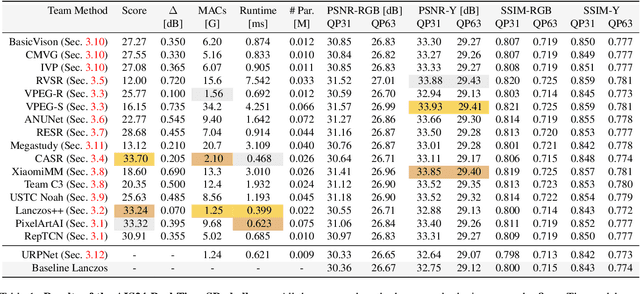

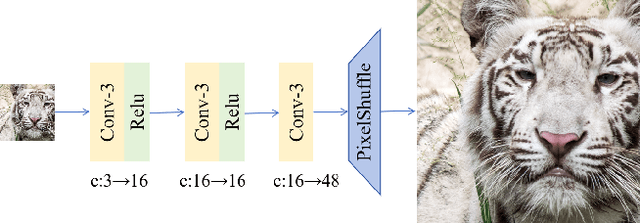
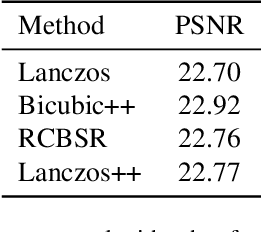
Abstract:This paper introduces a novel benchmark as part of the AIS 2024 Real-Time Image Super-Resolution (RTSR) Challenge, which aims to upscale compressed images from 540p to 4K resolution (4x factor) in real-time on commercial GPUs. For this, we use a diverse test set containing a variety of 4K images ranging from digital art to gaming and photography. The images are compressed using the modern AVIF codec, instead of JPEG. All the proposed methods improve PSNR fidelity over Lanczos interpolation, and process images under 10ms. Out of the 160 participants, 25 teams submitted their code and models. The solutions present novel designs tailored for memory-efficiency and runtime on edge devices. This survey describes the best solutions for real-time SR of compressed high-resolution images.
Traditional Transformation Theory Guided Model for Learned Image Compression
Feb 24, 2024Abstract:Recently, many deep image compression methods have been proposed and achieved remarkable performance. However, these methods are dedicated to optimizing the compression performance and speed at medium and high bitrates, while research on ultra low bitrates is limited. In this work, we propose a ultra low bitrates enhanced invertible encoding network guided by traditional transformation theory, experiments show that our codec outperforms existing methods in both compression and reconstruction performance. Specifically, we introduce the Block Discrete Cosine Transformation to model the sparsity of features and employ traditional Haar transformation to improve the reconstruction performance of the model without increasing the bitstream cost.
Depth Super-Resolution from Explicit and Implicit High-Frequency Features
Mar 16, 2023



Abstract:We propose a novel multi-stage depth super-resolution network, which progressively reconstructs high-resolution depth maps from explicit and implicit high-frequency features. The former are extracted by an efficient transformer processing both local and global contexts, while the latter are obtained by projecting color images into the frequency domain. Both are combined together with depth features by means of a fusion strategy within a multi-stage and multi-scale framework. Experiments on the main benchmarks, such as NYUv2, Middlebury, DIML and RGBDD, show that our approach outperforms existing methods by a large margin (~20% on NYUv2 and DIML against the contemporary work DADA, with 16x upsampling), establishing a new state-of-the-art in the guided depth super-resolution task.
Rethinking Blur Synthesis for Deep Real-World Image Deblurring
Sep 28, 2022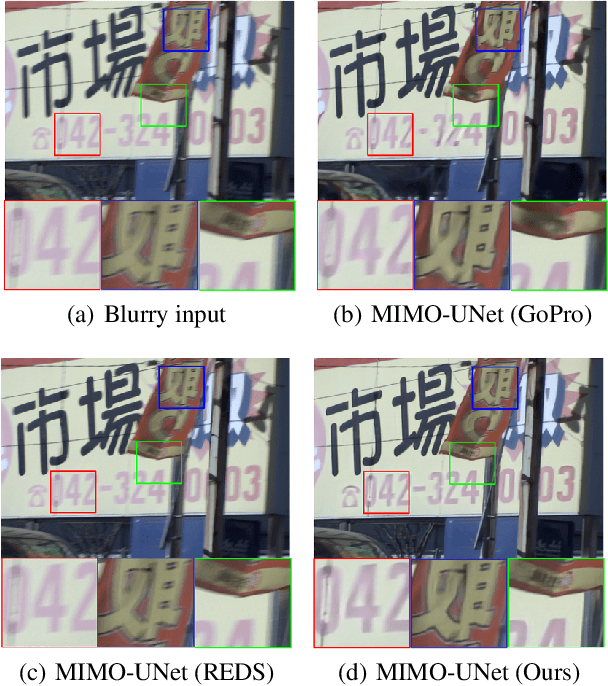
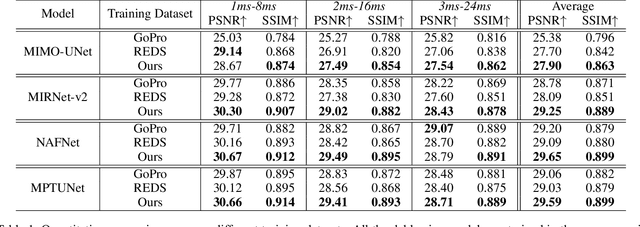


Abstract:In this paper, we examine the problem of real-world image deblurring and take into account two key factors for improving the performance of the deep image deblurring model, namely, training data synthesis and network architecture design. Deblurring models trained on existing synthetic datasets perform poorly on real blurry images due to domain shift. To reduce the domain gap between synthetic and real domains, we propose a novel realistic blur synthesis pipeline to simulate the camera imaging process. As a result of our proposed synthesis method, existing deblurring models could be made more robust to handle real-world blur. Furthermore, we develop an effective deblurring model that captures non-local dependencies and local context in the feature domain simultaneously. Specifically, we introduce the multi-path transformer module to UNet architecture for enriched multi-scale features learning. A comprehensive experiment on three real-world datasets shows that the proposed deblurring model performs better than state-of-the-art methods.
 Add to Chrome
Add to Chrome Add to Firefox
Add to Firefox Add to Edge
Add to Edge